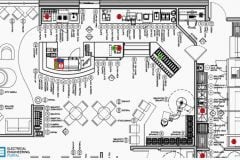
PVC is the most widely used nonmetallic jacketing material in the wire and cable industry. Starting in 1935, when it first became available, the use of PVC grew rapidly because of its low cost, its easy processing, and its excellent combination of overall properties including fire and chemical resistance. PVC belongs to a group of polymers referred to as vinyls. The unmodified polymer contains approximately 55 % chlorine. It is fairly linear in structure (few side chains) with approximately 5 to 10 % crystallinity.
The material must be compounded with additives such as fillers, plasticizers, and stabilizers to attain flexibility, heat resistance, and low temperature properties. General purpose jacketing materials normally posses good physical strength, moisture resistance, adequate oil resistance, good flame resistance and excellent resistance to weathering and to soil environments. Flame resistance and low temperature flexibility can both be improved within limits by the use of additives.
General purpose PVC compounds are recommended for installation at temperatures above -10 “C, but specially formulated compounds may be used as low as -40 “C. One of the limitations of PVC jacketed cable is its tendency to creep under continuous pressure. For this reason, cables which are to be supported vertically with grips should not have PVC jackets. Hypalon or neoprene are recommended for such use.
Low voltage
In the low voltage field, PVC is widely used as a single layer of material where it functions both as insulation and jacket. Since PVC is a thermoplastic material, it cannot take high temperatures. Under high current fault conditions the insulation can be permanently damaged by melting or can emit plasticizers and become stiff and brittle.
For this reason, it is not used as utility secondary network cable. Similarly, in industries that handle large amounts of heated material, or where there is the possibility of excessive heat, the use of PVC is avoided because of its tendency to melt or deform when heated to a high temperature.
Under continuous dc voltage in wet locations, as in battery operated control circuits, single-conductor PVC-insulated cables have frequently failed due to electro-endosmosis (water vapor ingress created by voltage stress).
The large percentage of chlorine can be released during a fire. When combined with moisture, hydrochloric acid may be produced. This situation highlights one of the major problems that can result from the use of PVC.
Copyright Notice
This technical article is protected by U.S. and international copyright laws. Reproduction and distribution of PDF version of this technical article to websites such as Linkedin, Scribd, Facebook and others without written permission of the sponsor is illegal and strictly prohibited.© EEP-Electrical Engineering Portal.
Related electrical guides & articles
Premium Membership
Edvard Csanyi
Hi, I'm an electrical engineer, programmer and founder of EEP - Electrical Engineering Portal. I worked twelve years at Schneider Electric in the position of technical support for low- and medium-voltage projects and the design of busbar trunking systems.I'm highly specialized in the design of LV/MV switchgear and low-voltage, high-power busbar trunking (<6300A) in substations, commercial buildings and industry facilities. I'm also a professional in AutoCAD programming.
Profile: Edvard Csanyi











Excellent abstract, Thanks.
What do you recommend to test a cable (PVC) that has 30 years in service, in a substation.
Which standard I have to use? Will be possible for you to send me them
Thank in advanced
Julio
thanks for your helping ,it is good information , i wanna ask you somthing how i can calculate the cross section size of cable ,
i am electrical engineer ,work in Saudi Arabia until now i can not find a rule to calculate the cross section
plz help me
You must determine the smallest allowable cross-sectional area of circuit conductor (cable). You also must choose what method of installation of PVC insulation is your cable. According to selected rated electric current, you’ll be able to determine cross section of cable.
You can find this table in Electrical Installation Guide (chapter G – Sizing protection conductors) which can be downloaded here:
http://bit.ly/qHC0Pf
Hope this helped,
BR